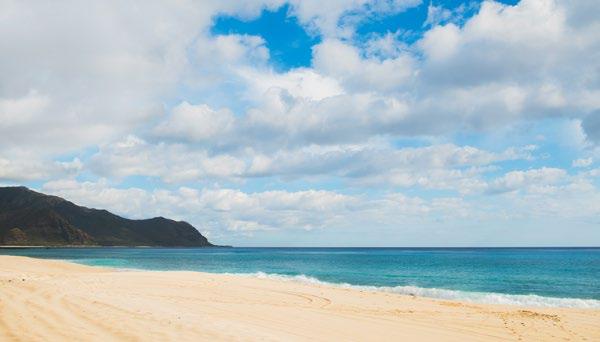
13 minute read
Introduction
Hawaiian Electric
Hawaiian Electric is dedicated to serving Hawai‘i’s energy needs and caring for our environment with purpose, compassion, empathy and aloha. Our role is to empower Hawai‘i, our communities, our customers and our employees to thrive, together.
Advertisement
In 2008, together with the state of Hawai‘i and the U.S. Department of Energy, we embarked on what was then viewed as an extraordinary journey to use renewable resources to power 40% of our electricity needs. Since then, Hawai‘i has embarked on an even bolder expedition, seeking to power the islands with 100% renewable energy and achieve a carbon neutral to carbon negative economy by 2045. These goals aim not only to reduce carbon emissions, but to increase our energy independence, resilience and economic strength.
Hawaiian Electric has been one of the most aggressive utilities in the nation in transitioning to renewable energy and working through complex technical issues and social equity considerations to keep our system stable, reliable and affordable for all our customers.
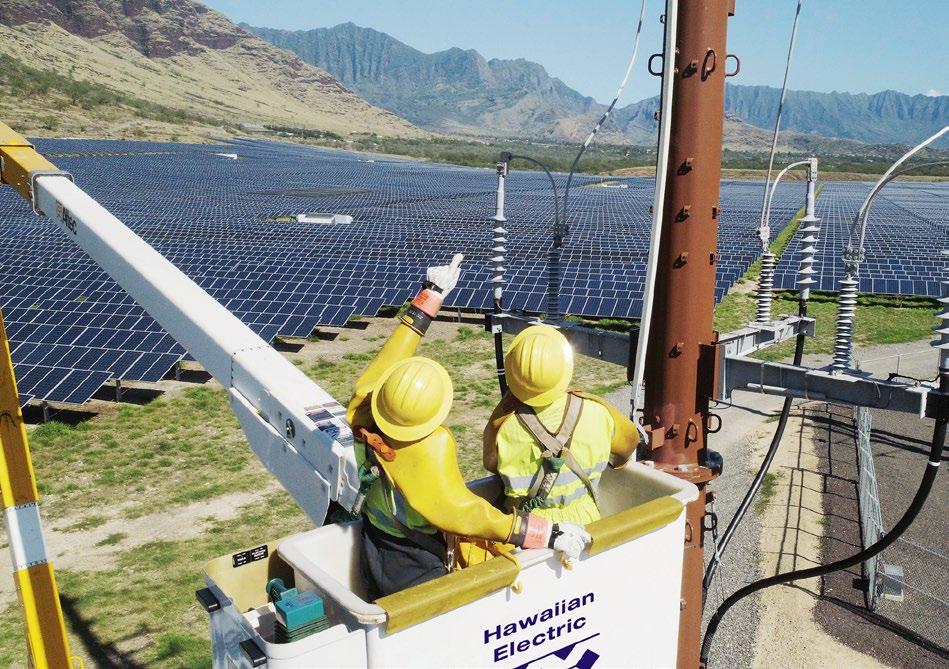
Partnering to Decarbonize Hawai‘i’s Economy 1
At Hawaiian Electric we are aligned with and committed to achieving our state’s goals — 30% RPS by 2020, 40% by 2030, 70% by 2040 and 100% by 2045. And, we’re working to get there faster.
In 2020 we achieved an RPS of 35%, exceeding the 30% milestone. While some of that outperformance was due to lower electric sales due to COVID-19, had sales been the same as in 2019 we still would have exceeded the 30% milestone with an RPS of 32%. We expect to surpass the next statutory RPS goal of 40% well before 2030. Both the company and our executives have financial incentives to achieve higher levels of RPS ahead of state targets. See “Metrics and Targets” on page 39 for more detail.
We know the utility alone will not set the pace of our transition. Factors such as affordability, reliability, social equity, indigenous and cultural considerations, limited land and competing needs for that resource will play a role in how and when we reach our goals. This is why we’re working with our community and our stakeholders to ensure we achieve our state’s renewable energy goals in a way that is right for Hawai‘i.
TOGETHER
EMPOWERING HAWAI‘I TO THRIVE 20/21
SUSTAINABILITY REPORT
Read our 2020-2021 Utility Sustainability Report
Renewable Portfolio Standard Progress
What is RPS? And What Affects It?
Renewable Portfolio Standard (RPS) represents the percentage of electricity sales that is satisfied with renewable energy:
Both the amount of renewable energy on the system and the amount of electricity sold affect the RPS result.
Factors that increase renewable generation or reduce electricity sales will cause RPS to rise. Conversely, factors that reduce renewable generation or increase electricity sales will cause RPS to decrease, or affect the timing in which we achieve our RPS goals.
RPS =
kWh of renewable energy generated kWh electricity sold
35%
2020 RPS
43.4% 30.5% 50.8%
HAWAI‘I ISLAND
O‘AHU
MAUI COUNTY
(Including Lāna‘i and Moloka‘i)
RPS Factors
Customer investments in rooftop solar and battery storage increase renewable generation and decrease sales, leading to higher RPS.
Energy efficiency measures reduce sales and thus increase
RPS.
Greater adoption of electric vehicles (EVs) increases sales and thus may increase the renewable generation needed to reach RPS goals; EVs have many other benefits for customers, the electric system and decarbonization efforts.
Economic conditions can affect electricity sales; for example,
COVID-19’s economic impacts reduced sales, causing RPS to increase.
Continuation of existing utility-scale renewable projects; for example, the outage of the geothermal plant on Hawai‘i
Island since 2018 has reduced renewable generation.
In addition, several factors can affect when new utility-scale renewable energy projects are brought online, including:
Availability of cost-effective projects, which can be affected by many factors, including cost of financing, materials and construction
Availability of land
59.6% Petroleum
2020 TOTAL SYSTEM GENERATION MIX
12.0% Coal 0.8% Biofuels 3.7% Biomass 0.1% Geothermal 0.3% Hydro 4.0% Utility-Scale Solar 13.5% Customer Solar
6.0% Wind
Our Generation Mix
1 3
Our renewable generation portfolio includes a diverse range of resources, including biomass, biofuels, wind, solar, hydro, geothermal and customer-sited solar. While grid-scale renewable energy is important, our largest source of renewable generation in 2020 was customer-sited solar.
Our current generation mix reflects our progress toward increasing renewable energy, as well as the resources available to serve as our “bridge fuel” during this transition. As batteries increase in capability and decline in price, we expect to add more to our system, enabling use of solar power at night or on cloudy days. For now, we need “firm” generation to provide enough electricity to meet demand and to balance fluctuations in intermittent solar and wind energy to ensure reliability, but these sources are limited in Hawai‘i. Geothermal, an excellent firm generation source, is only currently available on Hawai‘i Island. We have few and relatively small rivers to supply hydroelectric power. Biofuel is a small part of our energy mix today, and as cost-effective biofuel becomes available at greater scale we hope to add more. By state policy, nuclear generation is not allowed and the significant investment in and timeframe needed to import liquified natural gas is discouraged since it is a fossil fuel. Thus, as we work to advance and integrate more renewables, oil is our current “bridge fuel” to provide reliability. This impacts our generation mix as well as our GHG emissions.

Our Decarbonization Path
Adding Utility-Scale Renewable Energy and Storage 1
We are working aggressively to add more renewable energy to our system. Some of the new renewable energy facilities are owned by Hawaiian Electric, while many others are currently and are expected to continue to be developed and owned by thirdparty independent power producers (IPPs).
Our state’s policy is for the utility to create competitive procurements for the best technologies and pricing to provide energy options for our customers. We have a robust pipeline of utility-scale projects under development due to our recent renewable energy procurement efforts, the largest ever undertaken in Hawai‘i. Our online Renewable Project Status Board lists all pending renewable energy projects, how much they are anticipated to contribute to RPS, the year they are expected to come online and their current status.
Today the peak load for our entire five-island system is just over 1,600 MW. Together, projects under development or pending approval by the PUC from the two large renewable energy procurements we’ve run since 2018 have the potential to contribute an additional ~650 MW of solar and ~3 GWh of storage to our system by the end of 2023. Two of those are Hawaiian Electric self-build battery energy storage projects.
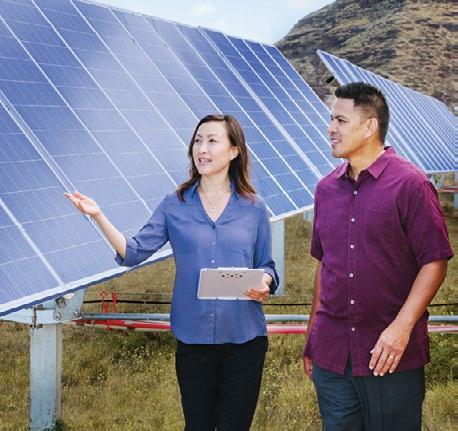

Deactivating Carbon-Based Generation 1
In 2014, we deactivated our 113-MW Honolulu Power Plant on O‘ahu and in 2015 we deactivated the 15.2-MW Shipman Plant on Hawai‘i Island. In September 2022, our power purchase agreement for the 180-MW coal-fired AES power plant on O‘ahu will expire, ending the use of coal for power generation in Hawai‘i. We’re also planning to deactivate our Kahului Power Plant on Maui by 2024 assuming sufficient replacement resources are online and two additional generating units at our Waiau facility on O‘ahu as soon as feasible, possibly in 2024.
Enabling Everyone to Participate in — and Benefit from — the Energy Transition 1 2 5
Hawai‘i has abundant sun and wind resources that can be harnessed for renewable energy. However, other resources, particularly land, are scarce, and shape how we’ll achieve our renewable energy goals. Thus, to reach our goals, we need as many customers as possible to adopt rooftop solar and community-based renewable energy (CBRE), and we’re transforming our grid to enable this to happen.
Today we have among the nation’s highest percentages of rooftop solar per capita (20% of residential customers, roughly 36% of single family homes on O‘ahu). We’ve invested heavily in our grid and in programs to integrate all of this intermittent, distributed generation while maintaining the reliability our customers expect. The pace of new rooftop solar additions picked up in 2020, with 56% more installed in 2020 than in 2019. Importantly, 78% of new rooftop solar applications also have battery storage. This allows daytime excess solar production to be used to reduce fossil-based power at night. We’re continually working to increase participation and make the interconnection process easier for customers. We’ve launched our new Quick Connect program to enable customers to interconnect their rooftop solar faster. We’re also pursuing grid services procurements to seek aggregations of customer rooftop solar, storage and other customer-sited resources to provide a range of services to the broader system.
One way we’re promoting equity is by developing programs for all customers to benefit from renewable energy, not just those who own their home and can afford to purchase their own rooftop solar system. In 2020, the PUC approved the second phase of our CBRE program, enabling up to 235 MW of renewable generation across our service territory. This new phase of CBRE will enable us to extend the benefits of clean energy to a wider range of residents, with priority to those who have been underrepresented in solar adoption, such as renters and customers with low-to-moderate incomes. In addition to private companies, Hawaiian Electric will be able to develop projects and recruit subscribers.
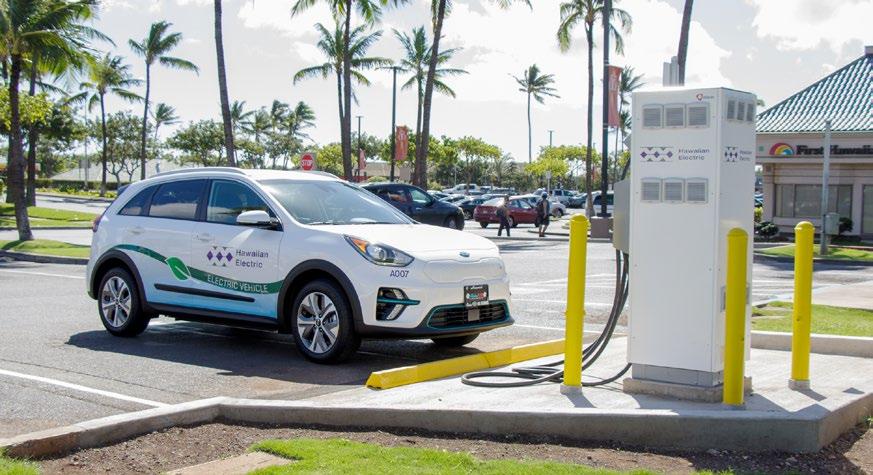
1 2 5
Transportation (ground, air and marine) is responsible for over half of Hawai‘i’s energy sector GHG emissions, with ground transportation accounting for the largest portion of transportation emissions.1 Increased renewable energy on our system and the growing market demand for electric vehicles (EVs) allows us to help decarbonize this sector. Hawai‘i has among the highest per capita rates of EVs in the country at 1.4 EVs per 100 passenger vehicles,2 which we expect to increase by at least 700% over the next 10 years.3
Electric transportation creates benefits for all customers by putting downward pressure on rates. This beneficial electrification spreads the cost of grid investments over more kilowatthours, reducing the per unit cost for everyone, and can be designed to provide grid services.
In 2016, we were founding partners of Drive Electric Hawai‘i, a coalition of public, private and nonprofit partners to promote transportation electrification. Hawaiian Electric’s 2017 EoT Strategic Roadmap set forth our electrification strategy, which includes 10 key initiatives. These initiatives result in three customer facing programs: public charging, EV rates and make-ready infrastructure. To date, Hawaiian Electric offers a network of 25 public chargers and rates for public and electric bus charging. In 2020, we filed proposals for commercial EV rates and pilot programs to offer make-ready infrastructure that serve bus operators, multiunit dwellings, commercial fleets, workplaces and charging hubs. We are leading by example by committing to electrify 100% of our light-duty fleet vehicles by 2035.
1 Hawaii Greenhouse Gas Emissions Report for 2016: Final Report.
2 As of March 2021.
HAWAI‘I HAS AMONG THE HIGHEST PER CAPITA RATES OF ELECTRIC VEHICLES (EVs)
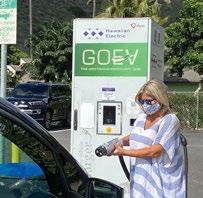
1.4 EVs
PER 100 REGISTERED PASSENGER VEHICLES AS OF MARCH 2021
Modernizing Our Grid
1 3 4
As more renewable energy, customer-sited resources and EVs come onto our system, we need a high-tech grid to manage this multiplicity of sources and ensure reliability.
Our Grid Modernization Strategy is designed to provide benefits for customers and for overall system management, including: empowering customers with information to better manage their usage and take advantage of different rates and programs to fit their needs, reducing the number of customers impacted by outages when they occur, as smart devices will be able to section off parts of the grid as needed, and giving system operators more visibility and control to promote reliability.
We’re implementing Phase 1, which includes advanced meters to provide more insight into the grid, a system to collect and store advanced meter data, and enabling the telecommunications network. When implemented, Phase 2 will include deployment of field devices such as remote switches and line sensors to automatically respond to grid conditions, and an advanced distribution management system.
Planning Holistically
1 2 3 4 5 6 7
Our December 2016 Power Supply Improvement Plan (PSIP) Update outlined potential scenarios to meet or exceed the state’s renewable energy milestones. This report laid the groundwork for the renewable energy RFPs we’ve implemented since that time.
In our next phase of long-range planning we’re pursuing a fully integrated planning and procurement process called Integrated Grid Planning (IGP). This approach appraises the total needs of the system — including generation, transmission, distribution and resilience needs — and considers alternatives for meeting those needs (from customer-sited resources, independent providers and the utility), and then selects the lowest cost / best fit solution(s) to operate the grid more reliably and affordably. This process includes planning for resilience and considers potential impacts from climate change. Our IGP process includes in-depth customer and other stakeholder feedback. We filed our first IGP review status report in early 2021 to present planning work and stakeholder contributions thus far. Future resource needs assessments and solution evaluations are now underway.
Empowering Hawai‘i to Thrive, Together
Hawaiian Electric’s strategic priorities are centered on building a stronger Hawai‘i, creating customer value, and strengthening the foundation of the utility. In serving its customers and communities, Hawaiian Electric aims to build long-term value for all stakeholders. The utility intends to:
Drive Hawai‘i’s efforts to diversify the economy, create local job and investment opportunities and reimagine a sustainable and equitable future
Build a modern and resilient portfolio of clean energy assets, including firm and variable generation
Develop a workforce recognized as high-performing, safetyoriented, flexible, diverse and inclusive
Serve as a trusted energy partner by collaborating with customers to provide solutions that are sustainable, affordable, reliable and tailored to create value
Improve financial performance by maximizing efficiency and streamlining operations
CREATE CUSTOMER VALUE
BUILD A STRONGER HAWAI‘I
STRENGTHEN COMPANY FOUNDATION
The utility’s ability to thrive through evolution and disruption is ultimately determined by the value it can deliver to its customers. Operating as efficiently as possible improves our overall capabilities while driving customer and community support. Stakeholder support facilitates our ability to develop new solutions and invest in the renewable energy transformation. These areas positively reinforce one another and build a sustainable source of shared value for years to come.
Exploring Carbon Offsets and Removal
1
The utility is pursuing a holistic decarbonization strategy to help achieve Hawai‘i’s carbon neutral to carbon negative economy goal. The company is evaluating levers beyond its priority focus on emissions reduction, including technologies around carbon removal, sequestration and offsets.
Regulatory Innovation
1 2 3 5 6 7
In December 2020, the PUC established performance-based regulation (PBR) for our utility, capping an over two-year process that included extensive utility involvement and stakeholder engagement. The new framework seeks to incentivize the utility to achieve environmental and social outcomes relating to energy affordability, reliability, customer equity, GHG emissions reduction, EoT and resilience.
Overall, we view the new framework as providing a balanced approach designed to provide value for customers and opportunities for the utility as we continue one of the nation’s most ambitious energy transformations. From an ESG standpoint, we view the PBR framework as providing a greater connection between our achievement of environmental and social goals and our financial performance. For example, under PBR, the utility now has financial incentives tied to performance on:
Accelerating achievement of Hawai‘i’s RPS goals
Achieving faster interconnection times for new distributed energy resources
Efficiently acquiring grid services capabilities from distributed energy resources
Collaborating to deliver energy savings for LMI customers
Effectively deploying and enabling advanced meters
The PUC and many parties involved in the PBR process recognized that the utility’s financial integrity is critical to Hawai‘i’s ability to achieve its climate goals and other societal outcomes.
